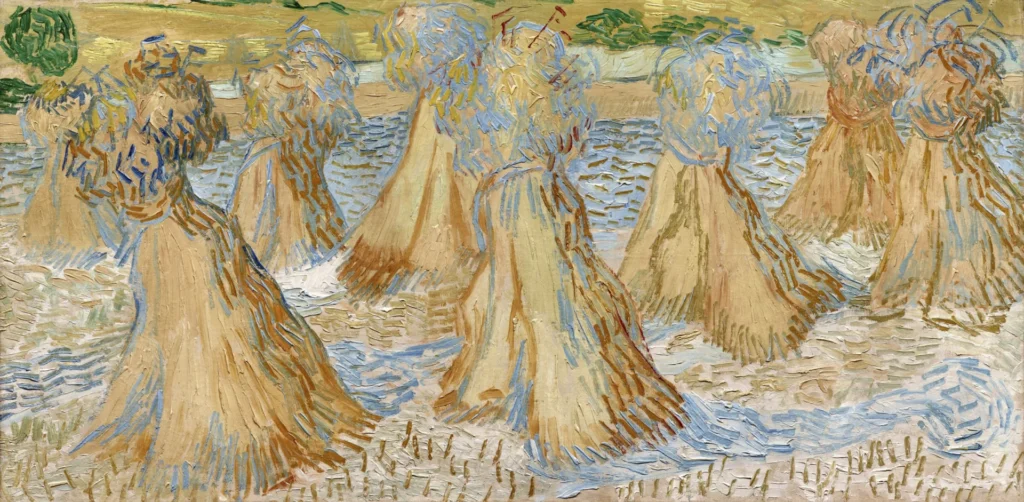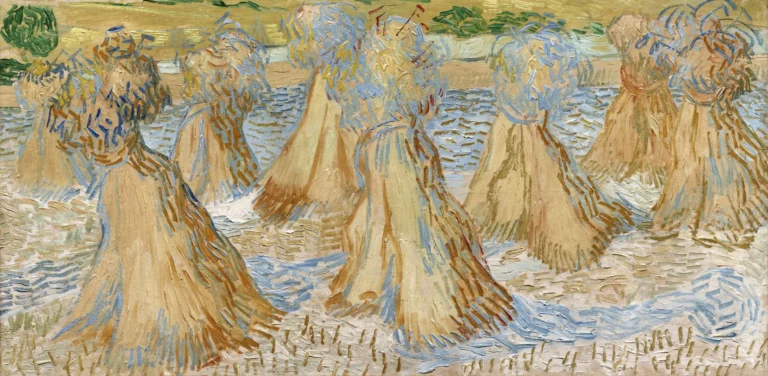Sheaves Of Wheat (1890)
Vincent van Gogh's Sheaves of Wheat, painted in July 1890, exemplifies the Post-Impressionist style he is renowned for. This remarkable landscape painting features a solitary bundle of wheat sheaves, masterfully rendered with Van Gogh's signature brushwork. The bold textures and colors used in this piece beautifully reflect his fascination with the agricultural life that surrounded him. Captured during his stay in Auvers-sur-Oise, the artwork resonates with themes of seasonal labor and the intricate beauty of nature, underscoring Van Gogh’s innovative artistic vision.
July 1890
About the Artwork
The story of Sheaves of Wheat unfolds in the final months of Vincent van Gogh's life, during his stay in Auvers-sur-Oise, France. This period marked a time of intense creativity and emotional struggle for the artist. Van Gogh was deeply inspired by the rural landscape, and the depiction of sheaves of wheat served as a poignant representation of the agricultural labor that shaped the countryside. His choice to focus on a single bundle instead of rows of sheaves not only highlights its importance but also showcases his ability to transform ordinary subjects into extraordinary artworks. The use of thick, textured brushstrokes conveys his emotional response to the scene, reflecting both the beauty and the transience of nature. Ultimately, it represents Van Gogh’s quest for peace and solace through his art, even amidst personal turmoil.
Did You Know
Liked what you see? Add it to your collection.
Enjoyed reading? Share it.
... continued
Date and Location
The painting was created in July 1890, while Van Gogh was in Auvers-sur-Oise, France.
Style and Genre
It is characterized by Van Gogh's Post-Impressionist style and falls under the genre of landscape painting.
Medium and Dimensions
The painting is executed in oil on canvas and measures 50.5 cm by 101 cm (or 50.5 cm by 100.9 cm, depending on the source).
Composition and Technique
The painting features a striking composition with a solitary bundle of sheaves centrally placed, which distinguishes it from other works where sheaves are depicted in rows. Van Gogh focused on texture and brushwork, using sturdy brushstrokes for the mown wheat field in the foreground and finer brushwork for the thin stalks of the bundled wheat sheaves. The background shows wheat still waiting to be harvested.
Current Location
The painting is part of the Wendy and Emery Reves Collection and is housed at the Dallas Museum of Art in Dallas, Texas, USA.
Significance
Sheaves of Wheat reflects Van Gogh's fascination with the depiction of seasonal farm labor, a theme that was central to his work, particularly during his time in Arles and Saint-Rémy. The painting showcases his innovative use of texture and brushwork, highlighting his unique artistic style.










